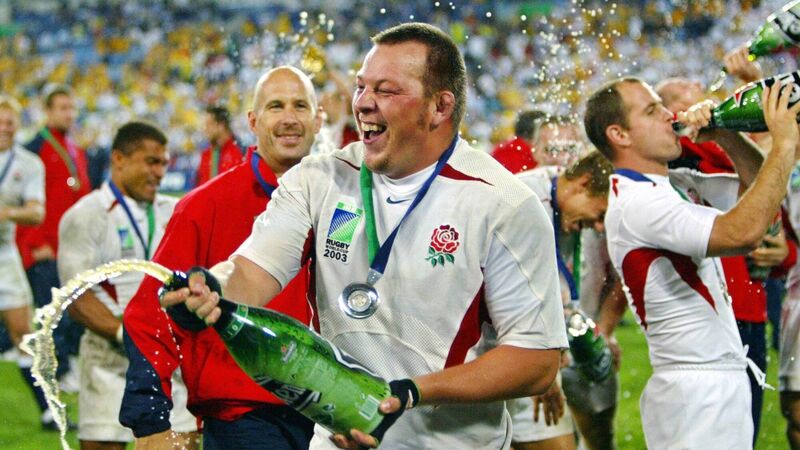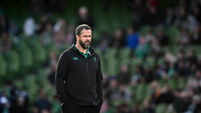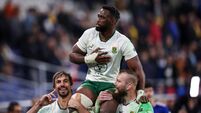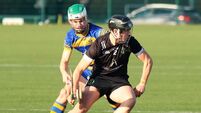Donal Lenihan: Two new hips and a new knee? Yep, I was one of the lucky ones

SUCCESS WITH A PRICE: English hooker Steve Thompson celebrates after winning the Rugby World Cup final at the Olympic Park Stadium in Sydney in 2003. Thompson now has no memory of the triumph.
The reunions tend to come around with a bit more regularity now. The older you get, the more you appreciate meeting up with team-mates from times past, be it from club, country, or at British and Irish Lions get-togethers.
The last such occasion involved a drive from Cork to Portballintrae, Co Antrim, a round trip of 1,034km for Michael Kiernan and I. If my first ever visit to the Giants Causeway left me somewhat underwhelmed — give me Slea Head any day — a tour of the Old Bushmills Distillery kickstarted a very enjoyable afternoon and late night with members of Irish squad that played at the inaugural World Cup in New Zealand and Australia 30 years earlier.
Organised by two of Ulster’s finest in Trevor Ringland and David Irwin, I did ask Ringland if he could have picked a spot further from the Rebel County? “You’re lucky” he said, “Rathlin Island was unavailable.”
It never ceases to amaze me how, despite the passage of time, the pockets of players who were especially friendly all those years ago tend to subconsciously gravitate towards one another. The craic, the stories, and the inevitable comparisons between the amateur game and its modern day professional equivalent never take long to surface.
Most express themselves happy to have played when they did with the one caveat, how much better could they have been with the benefit of full-time training and more nuanced coaching?
Inevitably the conversation strays to ‘how’s the body?’ ‘It’s not too bad, considering’, before quickly morphing into a body count of replacement joints and other sports-related ailments.
In the roll call of artificial joints, I shared top spot with one of the props on two hips and a knee. Our reward for sacrifices to the cause? Two free pints. How bad. Would we do it all again? The response was unanimous. Absolutely.
The question now is, will the same apply to the early graduates of the professional version of the game? In the majority of cases, I suspect the answer would still be yes. Tragically there will also be a cohort for whom the reality of having received a succession of concussive blows has resulted in cause for serious reflection, not least with the revelation that a large number of small blows to the head could be as dangerous as a small number of impacts that led to being knocked out.
The situation is best summarised by former Welsh international Alix Popham, who along with England’s 2003 World Cup-winning hooker Steve Thompson and others, has confirmed signs of the early onset of dementia, when saying: “We knew our bodies would be broken but not that the same would happen to our brains.”
This group of players has now instigated a case against rugby’s governing body World Rugby, the RFU and the WRU. There are also a number of former IRFU contracted players waiting in the wings to join this action.
Given the lessons from American Football and the successful class action taken by former players against the NFL, it was inevitable that the rugby authorities would face a similar suit. In reality, the rugby authorities have been preparing for it for some time.
In response to a lawsuit filed on behalf of more than 4,500 ex-American footballers in 2012, the NFL agreed to a settlement of $765m (€625m) in 2014 with the final agreement allowing for up to $1bn (€817m) in compensation for retired players with serious medical conditions linked to repeated head trauma.
A key element in this case was in proving that the NFL authorities had deliberately concealed evidence linking concussions and traumatic brain injuries. Therefore, this case could well come down to what information was available to the rugby authorities in relation to the effects of concussive blows to the head at the time the players taking action were playing.
No doubt the authorities will point to the fact that specific protocols, designed around the best information available at the time, were in place. The question then shifts to whether those guidelines were adhered to by those in authority with club and country.
There are a number of horror stories surrounding some practices at the time.
Former Clermont Auvergne second row Jamie Cudmore has been embroiled in a legal battle with the club he played for with distinction for 11 years, after a series of concussive incidents as recently as 2015.
Clearly concussed after a head clash with Billy Vunipola in the semi-final of the Heineken Champions Cup against Saracens that year, he was declared unfit to continue by the physio after examination.
Stitched up and just out of the shower, his second row partner Sebastian Vahaamahina was then injured and also ruled out by the medical team in the dressing room. Despite being ruled out earlier, Cudmore was then asked to put his gear back on and return to action on the field.
A few weeks later, in the final against Toulon, he took a heavy knock early on but passed the HIA.
After receiving another bang in the second half he was removed to be stitched up but, despite vomiting in the dressing room, was once again sent back on. In the weeks that followed Cudmore suffered serious side-effects. This is a case where the alleged breach of protocols by the club is the issue rather than the governing body.
As a game, rugby is unrecognisable from the one that existed prior to professionalism 25 years ago.
The players are bigger, faster, and stronger. The introduction of Rugby League coaches around 1999 led to the emphasis switching from attack to defence with the mantra ‘defence wins trophies’ becoming the new norm.
New phraseology entered the game. There is a differentiation in the post-match analysis on the type of tackles made by players. Defence coaches want to see more ‘dominant tackles’ — where you propel the ball carrier backwards with the ferocity of the hit — as opposed to ‘soak tackles’ — where you make the tackle but the ball carrier wins the collision and maintains forward momentum. Players are castigated by the defence coach for not getting back up off the ground, despite the severity of the hit taken, to get back into the defensive line.
Four years ago when writing my autobiography, , I highlighted the urgent need to reduce the number of substitutes from eight to six. The facility to carry six forwards on the bench, many of whom weigh in at over 20 stone but with an aerobic capacity to only last about 30 minutes, is destroying the game.
We now have a major mismatch with an out-half, centre, or winger having to tackle players five and six stone heavier at a time when they are fatigued after 70 minutes of action. The potential for serious damage is clear.
In addition, the prospect of the better team pulling away in the final quarter of the game is reduced by allowing so many substitutes.
It is somewhat ironic that in the amateur days, any suspicion of a concussion led to an automatic three-week ban from playing the game. In that we were better served by our medics, even if we did not always appreciate it at the time.
On the basis of what we are discovering now, I think many a former pro will gladly settle for the odd limp or a few artificial joints.
When the England World Cup-winning squad have their 20-year reunion, the realisation that Thompson has no recollection whatsoever of winning the Webb Ellis trophy in Sydney in 2003 is sure to cast a shadow on the celebrations. As former players, some are sure to ponder, what price is too high to pay for a professional career?









